Saturday, June 5
Paula: We left Gibbs Farm early this morning heading south toward Lake Eyasi with plans to spend the next two days camping with the Hadza. The Hadza is one of the few groups of hunter-gatherers left in the world, and the only one in Tanzania. An estimated 2,000-3,000 Hadzas remain in Tanzania, essentially living as they have for thousands of years. The Hadza live together in small groups of 10-20 people, and continually move their settlements in search of food and water. Their territory in Tanzania has been slowly shrinking as neighboring tribes that herd and cultivate food continue to expand. Nassibu told us that locating them can require a little patience, but assured us that we would find them (or they would find us) once we arrived in the right general area.
We began by driving through Kuratu, a growing town near Gibbs Farm that until recently was very small. The introduction of electricity and the paved road between Arusha and Kuratu has suddenly made the town highly accessible and it has grown significantly during the past five years. It appears that this is happening in many of the small communities throughout Tanzania. Though these towns have electricity, there is often no running water and we haven't seen many signs of telephones or televisions.
We spent time during the drive watching people along the road, trying to
identify their tribes. As in India, we frequently passed areas where people
were collecting water to take back to their homes. This is often a job for
the women and children, many carrying water in buckets on top of their heads,
on their bikes or using ox-drawn carts. We saw many more people w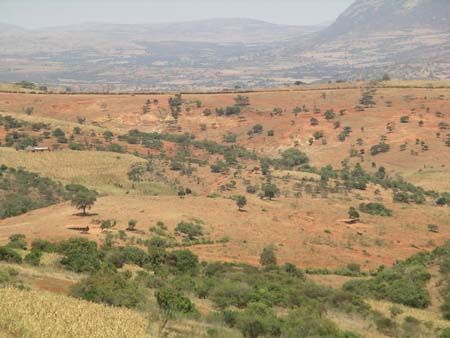 alking
the road than we saw cars. Many people stood waiting for a bus but most buses
that we saw were already crammed with people inside, often with many young
men sitting on top. Nassibu told us that sometimes people wait for hours,
only to have to walk home at night after not finding any buses at all.
alking
the road than we saw cars. Many people stood waiting for a bus but most buses
that we saw were already crammed with people inside, often with many young
men sitting on top. Nassibu told us that sometimes people wait for hours,
only to have to walk home at night after not finding any buses at all.
We passed through many fields with a variety of crops (mostly corn and millet), as most of the tribes in the area now depend on agriculture. It seemed strange to see banana trees growing between and sometimes right in the middle of corn fields (we've never seen that in Indiana!). We saw several soccer fields set up along the corn fields and everywhere we drove we were greeted by waving children often chewing on sticks of sugar cane.
We stopped at one point to admire the countryside and spotted five Mbulu homes. Their homes are difficult to see (they are hidden in the picture above) because they are built into a hillside with one side blending right into the dirt. During our picnic lunch, we were joined by a group of Mbulu children curious about our journey.
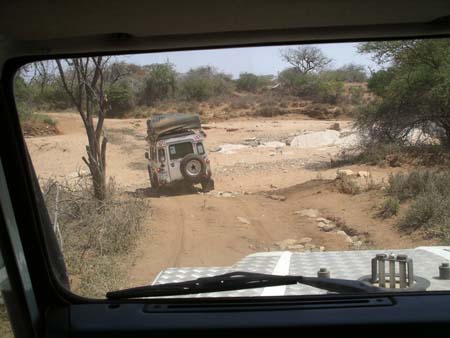 It
took us about 4 ½ hours to finally reach the Kidero region where the
Eastern Hadza live (there is also a western group on the other side of Lake
Eyasi, but they are said to moving quickly away from their traditional lifestyle).
The final two hours of the drive were spent in very difficult terrain requiring
us to go slowly and cautiously. In many places, we could not even see the
road, only rocks and dry vegetation. Nassibu somehow always seems to know
exactly where we are supposed to go. Fortunately, the conditions were not
as bad as Nassibu had feared - apparently this year's wet season was relatively
kind to the roads.
It
took us about 4 ½ hours to finally reach the Kidero region where the
Eastern Hadza live (there is also a western group on the other side of Lake
Eyasi, but they are said to moving quickly away from their traditional lifestyle).
The final two hours of the drive were spent in very difficult terrain requiring
us to go slowly and cautiously. In many places, we could not even see the
road, only rocks and dry vegetation. Nassibu somehow always seems to know
exactly where we are supposed to go. Fortunately, the conditions were not
as bad as Nassibu had feared - apparently this year's wet season was relatively
kind to the roads.
As we entered the dusty plains of the Kidero region, we began seeing the
homes of the Datoga tribe. The Datogas herd animals and grow crops. Nassibu
told us we could identify them both by their dress and by their spears which
have a shorter metal blade and longer wooden stick than that of the Maasi.
We learned that the Datoga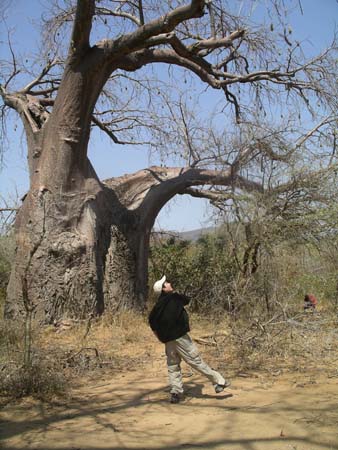 's
spears are designed to be light so that they can be thrown, while the Maasi
traditionally keep their spears in their hands.
's
spears are designed to be light so that they can be thrown, while the Maasi
traditionally keep their spears in their hands.
We stopped to pick the fruits of the Boabab Tree. This very large and unique
tree bears green fruit with a hard outer shell and is a common food of the
Hadza. Nassibu thought that these would make a nice gift for the Hadza and
we had fun throwing sticks up into the tree to knock down the  fruit.
Four nearby Datoga children joined in the fun and we learned how to say hello
in Datoga (sayou). The children were eager to have their pictures taken and
ran behind the Land Rover for quite a distance once we left.
fruit.
Four nearby Datoga children joined in the fun and we learned how to say hello
in Datoga (sayou). The children were eager to have their pictures taken and
ran behind the Land Rover for quite a distance once we left.
It wasn't long before Nassibu was stopping the car to greet a Hadza family
living in a small settlement by the road. We also passed a teenage boy carrying
his bow and arrows. This was our first exposure to the 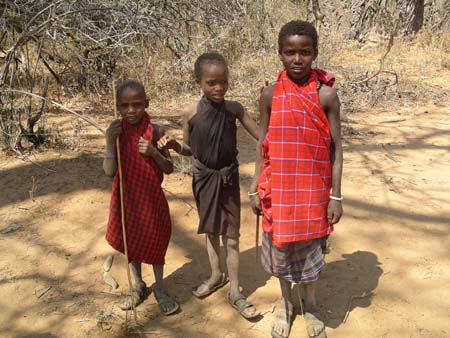 Hadza,
and when we asked Nassibu whether the boy was hunting, we learned that the
Hadza normally carry their bow and arrows with them at all times in case they
happen to encounter animals that can be hunted.
Hadza,
and when we asked Nassibu whether the boy was hunting, we learned that the
Hadza normally carry their bow and arrows with them at all times in case they
happen to encounter animals that can be hunted.
By this time, the Land Rover with all our camping gear had gone ahead and
to scout out a campsite. Once we reached their location, we found at least
four Hadzas that were already helping out. Nassibu told us that when the Hadza
hear a car on the road they enjoy coming out to greet their visitors and will
often lend a hand. 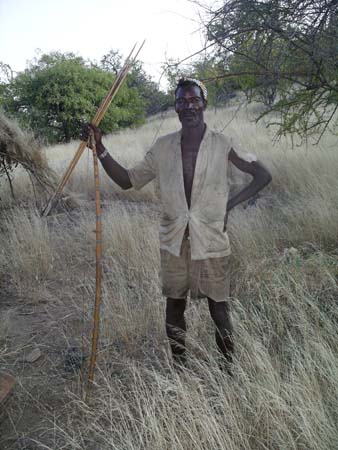
Before dinner, Nassibu introduced us to Asani, a Hadza man who appears to be in his mid-50's. Asani and his family had just recently moved their homes from the surrounding hillside down into the valley close to our camp, and he offered to take us to his home. We followed this small yet strong man who wore cut off denims, a torn shirt, sandals made out of old rubber tires and a beaded headband. He carried a small machete on his belt with a bow and handful of arrows.
At first we were surprised that the Hadza don't wear traditional clothes. The Hadza have a lifestyle that is probably the more different than any that we have seen during our travels. The Hadza have also been very resistant to change. Despite this, unlike some of the other tribes we have visited, they have not kept their traditional clothing. Nassibu told us that they basically wear what they can get and have found it easier to purchase clothing when they need it at a market across the valley. After thinking about it, we decided that this is very consistent with their character. For example, they hunt, gather and eat when they are hungry but seldom store or save food. They collect honey for eating and trading but haven't tried to farm honey even though they have seen how this is done by the neighboring Datogas.
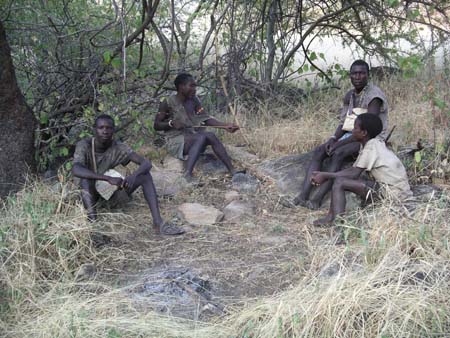 When
we arrived at their camp, we found four of Asani's sons sitting around a small
fire sharpening their arrows. In a separate area of the camp, the women were
sitting in a small group talking and sharing the remains of a roasted warthog
caught earlier by the men. They were also grinding the seeds from the baobab
fruit to make a pasty porridge. They were ha
When
we arrived at their camp, we found four of Asani's sons sitting around a small
fire sharpening their arrows. In a separate area of the camp, the women were
sitting in a small group talking and sharing the remains of a roasted warthog
caught earlier by the men. They were also grinding the seeds from the baobab
fruit to make a pasty porridge. They were ha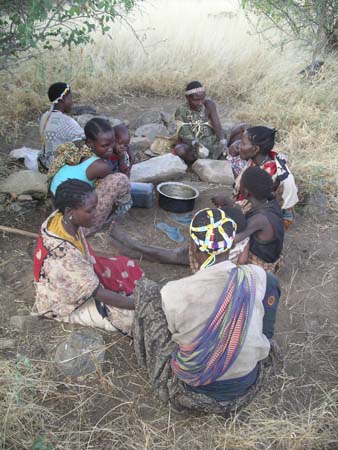 ppy
to accept our additional baobabs as a gift. The group of women included Asani's
wife, two daughters, two daughters-in-law and two small grandchildren. Asani's
wife was wearing an animal skin decorated with beads, while the other women
wore western-style tops with cloth wrapped around their waists as a skirt.
ppy
to accept our additional baobabs as a gift. The group of women included Asani's
wife, two daughters, two daughters-in-law and two small grandchildren. Asani's
wife was wearing an animal skin decorated with beads, while the other women
wore western-style tops with cloth wrapped around their waists as a skirt.
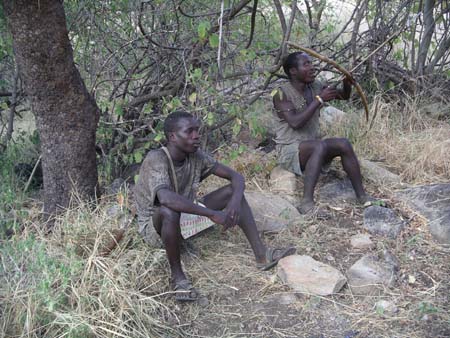 After
Asani introduced us to the women, he left us to chat with them and returned
himself to the group of men. The men and women have clearly defined roles
and do not spend time together during the day. While the men hunt and collect
honey, the women spend their days gathering berries, roots, watching the children
and building their temporary homes.
After
Asani introduced us to the women, he left us to chat with them and returned
himself to the group of men. The men and women have clearly defined roles
and do not spend time together during the day. While the men hunt and collect
honey, the women spend their days gathering berries, roots, watching the children
and building their temporary homes.
We listened to them talk among themselves using a click language. Although
not every word seems to contain the clicks, we could still hear these sounds
scattered in their conversation. One of the women had attended school for
a few years and she was the only person who knew how old she was. They sat
around a small fire and used only a few items to cook with - a small metal
pot for boiling roots, two rocks used for grinding seeds and a plastic container
to collect water. We were told that these were the only cooking supplies used
by the entire family. 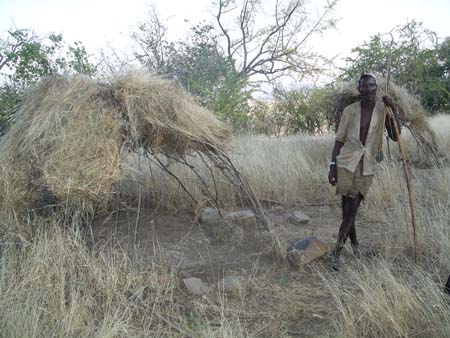
The small homes here were still under construction. The frame of the homes
are made out of sticks and then covered with dried grass. Grass is also applied
to the floor for sleeping. The homes are simple and primarily used for sleeping.
The homes we saw had absolutely no personal possessions inside - the few items used in
the camp are kept in a central area. We learned that in the rainy season,
the Hadza often stay closer to caves where they can seek better shelter.
saw had absolutely no personal possessions inside - the few items used in
the camp are kept in a central area. We learned that in the rainy season,
the Hadza often stay closer to caves where they can seek better shelter. 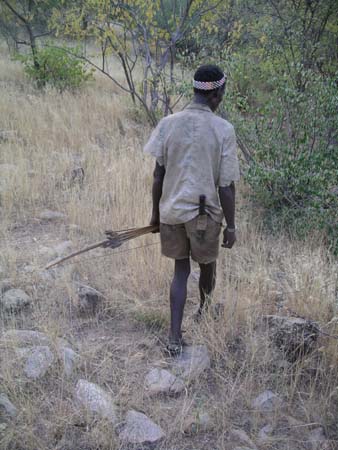
We also enjoyed talking to the men. Of the four, two had made kills today
- a dik-dik and warthog. David particularly enjoyed seeing their arrows -
some are used for hunting birds and small animals, while others have large
arrowheads with poison for large animals. The metal arrowheads are pounded
out of nails and sh arpened
with stones.
arpened
with stones.
Before leaving, we learned how to say hello (umtana) and thank you (newbaya) in the Hadza's language. They all laughed, but seemed to appreciate our attempts.
We headed back to camp before sunset and enjoyed popcorn and roasted corn-on-the-cob
by the campfire. The staff 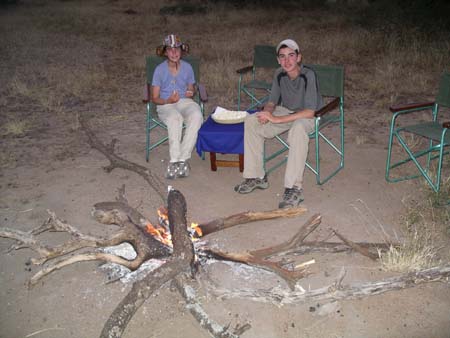 prepared
another wonderful meal, sending us to our tents with full and satisfied stomachs.
prepared
another wonderful meal, sending us to our tents with full and satisfied stomachs.
Tomorrow we plan to accompany the Hadza as part of their daily routines. Asani will take us hunting in the morning and we plan on digging roots in the afternoon with the women.
